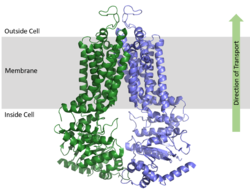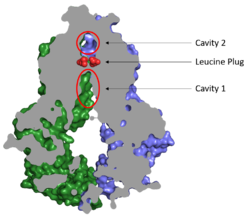Sandbox Reserved 1606
From Proteopedia
(Difference between revisions)
| Line 30: | Line 30: | ||
===Cancer=== | ===Cancer=== | ||
| - | ABCG2 hinders cancer treatment by contributing to [https://en.wikipedia.org/wiki/Multiple_drug_resistance multidrug resistance] in tumor cells. | + | ABCG2 hinders cancer treatment by contributing to [https://en.wikipedia.org/wiki/Multiple_drug_resistance multidrug resistance] in tumor cells. ABCG2 exports xenbiotics, including vital anti-cancer drugs, which results in the inability to treat cancer cells. Cancer patients typically show high levels of expression of multiple ABC transporters. For example, [https://en.wikipedia.org/wiki/Acute_myeloid_leukemia acute myeloid leukemia] (AML) has shown increased expression of [https://en.wikipedia.org/wiki/P-glycoprotein ABCB1], [https://en.wikipedia.org/wiki/ABCG1 ABCG1], and ABCG2 while childhood AML shows an increased expression in [https://en.wikipedia.org/wiki/ABCA3 ABCA3], ABCB1, [https://en.wikipedia.org/wiki/ABCC3 ABCC3], and ABCG2.<ref name="Marzac"/><ref name="Bartholomae"/> Additionally, pancreatic cancer has shown an upregulation of ABCB4, ABCB11, ABCC1, ABCC3, ABCC5, ABCC10, and ABCG2.<ref name="Mohelnikova-Duchonova"/> |
| + | |||
| + | The substrate specificity among ABC transporters varies so this protein family can collectively export a wide variety of substrates and, ultimately, a wide variety of anticancer drugs. ABCG2 has been known to export anticancer drugs such methotrexate, mitoxantrone, topotecan, irinotecan, and flavopiridol (52). Due to the high expression of multiple ABC transporters, treatment of multiple transporters would likely be necessary for successful cancer treatment. | ||
===Inhibitors=== | ===Inhibitors=== | ||
| + | ABCG2 hinders cancer treatment by contributing to [https://en.wikipedia.org/wiki/Multiple_drug_resistance multidrug resistance] in tumor cells. ABCG2 exports xenbiotics, including vital anti-cancer drugs, which results in the inability to treat cancer cells. The inhibition of ABCG2 would stop the transport of anti-cancer drugs out of cancer cells. Due to the potential for ABCG2 inhibition to aid in cancer treatment, efforts have been made to develop specific inhibitors of ABCG2 and other ABC transporters. Some promising inhibitors were derived from fungal toxin [https://en.wikipedia.org/wiki/Fumitremorgin fumitremorgin C]; however, many of those derivatives developed have neurotoxic effects.<ref name="Jackson"/> | ||
| + | |||
ABCG2 <scene name='83/832932/Inhibitor_bound_cavity_1/1'>inhibitors</scene> that bind Cavity 1, acting as competitive inhibitors against ABCG2 substrates. Depending on the size of the inhibitor, one or two molecules can accommodate binding to the cavity and form <scene name='83/832932/Inhibitor_intxns_cavity1/1'>hydrogen bonds, van der Waals, and stacking interactions</scene> within the binding site.<ref name="Jackson"/> Many inhibitors are too big to be transported via the leucine plug resulting in the "clogging" of the transporter. With inhibitors acting as wedges, ABCG2 is locked in the inward-facing conformation and unable to transport molecules out of the cell.<ref name="Manolaridis"/> | ABCG2 <scene name='83/832932/Inhibitor_bound_cavity_1/1'>inhibitors</scene> that bind Cavity 1, acting as competitive inhibitors against ABCG2 substrates. Depending on the size of the inhibitor, one or two molecules can accommodate binding to the cavity and form <scene name='83/832932/Inhibitor_intxns_cavity1/1'>hydrogen bonds, van der Waals, and stacking interactions</scene> within the binding site.<ref name="Jackson"/> Many inhibitors are too big to be transported via the leucine plug resulting in the "clogging" of the transporter. With inhibitors acting as wedges, ABCG2 is locked in the inward-facing conformation and unable to transport molecules out of the cell.<ref name="Manolaridis"/> | ||
</StructureSection> | </StructureSection> | ||
| Line 40: | Line 44: | ||
<ref name="Robey">PMID:29643473</ref> | <ref name="Robey">PMID:29643473</ref> | ||
<ref name="Jackson">PMID:29610494</ref> | <ref name="Jackson">PMID:29610494</ref> | ||
| + | <ref name="Marzac">PMID:21606172</ref> | ||
| + | <ref name="Bartholomae">PMID:26512967</ref> | ||
| + | <ref name="Mohelnikova-Duchonova">PMID:23462326</ref> | ||
| + | |||
<references/> | <references/> | ||
==Student Contributors== | ==Student Contributors== | ||
Julia Pomeroy | Julia Pomeroy | ||
Revision as of 01:29, 18 April 2020
| This Sandbox is Reserved from Jan 13 through September 1, 2020 for use in the course CH462 Biochemistry II taught by R. Jeremy Johnson at the Butler University, Indianapolis, USA. This reservation includes Sandbox Reserved 1598 through Sandbox Reserved 1627. |
To get started:
More help: Help:Editing |
ABCG2 Multidrug Transporter
References
- ↑ 1.0 1.1 1.2 1.3 1.4 Taylor NMI, Manolaridis I, Jackson SM, Kowal J, Stahlberg H, Locher KP. Structure of the human multidrug transporter ABCG2. Nature. 2017 Jun 22;546(7659):504-509. doi: 10.1038/nature22345. Epub 2017 May, 29. PMID:28554189 doi:http://dx.doi.org/10.1038/nature22345
- ↑ 2.0 2.1 2.2 2.3 2.4 2.5 2.6 Manolaridis I, Jackson SM, Taylor NMI, Kowal J, Stahlberg H, Locher KP. Cryo-EM structures of a human ABCG2 mutant trapped in ATP-bound and substrate-bound states. Nature. 2018 Nov;563(7731):426-430. doi: 10.1038/s41586-018-0680-3. Epub 2018 Nov, 7. PMID:30405239 doi:http://dx.doi.org/10.1038/s41586-018-0680-3
- ↑ 3.0 3.1 Robey RW, Pluchino KM, Hall MD, Fojo AT, Bates SE, Gottesman MM. Revisiting the role of ABC transporters in multidrug-resistant cancer. Nat Rev Cancer. 2018 Jul;18(7):452-464. doi: 10.1038/s41568-018-0005-8. PMID:29643473 doi:http://dx.doi.org/10.1038/s41568-018-0005-8
- ↑ 4.0 4.1 4.2 4.3 Jackson SM, Manolaridis I, Kowal J, Zechner M, Taylor NMI, Bause M, Bauer S, Bartholomaeus R, Bernhardt G, Koenig B, Buschauer A, Stahlberg H, Altmann KH, Locher KP. Structural basis of small-molecule inhibition of human multidrug transporter ABCG2. Nat Struct Mol Biol. 2018 Apr;25(4):333-340. doi: 10.1038/s41594-018-0049-1. Epub, 2018 Apr 2. PMID:29610494 doi:http://dx.doi.org/10.1038/s41594-018-0049-1
- ↑ 5.0 5.1 Marzac C, Garrido E, Tang R, Fava F, Hirsch P, De Benedictis C, Corre E, Lapusan S, Lallemand JY, Marie JP, Jacquet E, Legrand O. ATP Binding Cassette transporters associated with chemoresistance: transcriptional profiling in extreme cohorts and their prognostic impact in a cohort of 281 acute myeloid leukemia patients. Haematologica. 2011 Sep;96(9):1293-301. doi: 10.3324/haematol.2010.031823. Epub, 2011 May 23. PMID:21606172 doi:http://dx.doi.org/10.3324/haematol.2010.031823
- ↑ 6.0 6.1 Bartholomae S, Gruhn B, Debatin KM, Zimmermann M, Creutzig U, Reinhardt D, Steinbach D. Coexpression of Multiple ABC-Transporters is Strongly Associated with Treatment Response in Childhood Acute Myeloid Leukemia. Pediatr Blood Cancer. 2016 Feb;63(2):242-7. doi: 10.1002/pbc.25785. Epub 2015 Oct, 29. PMID:26512967 doi:http://dx.doi.org/10.1002/pbc.25785
- ↑ 7.0 7.1 Mohelnikova-Duchonova B, Brynychova V, Oliverius M, Honsova E, Kala Z, Muckova K, Soucek P. Differences in transcript levels of ABC transporters between pancreatic adenocarcinoma and nonneoplastic tissues. Pancreas. 2013 May;42(4):707-16. doi: 10.1097/MPA.0b013e318279b861. PMID:23462326 doi:http://dx.doi.org/10.1097/MPA.0b013e318279b861
Student Contributors
Julia Pomeroy


